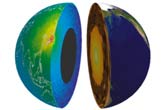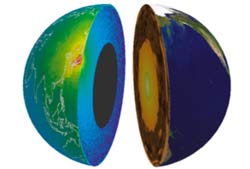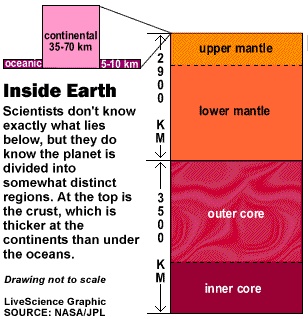Breakthrough: New Way to Peek Inside Earth

The heart of our planet is largely a mystery because scientists can't go there or see what's inside. Geologists have just one tool, seismology, with which to probe the inner Earth.
The contents of the tool bag just doubled.
For the first time, researchers have detected tiny particles called geoneutrinos coming from deep within the Earth. The discovery is expected to shed light, almost literally, on the contents and processes of the planet's insides.
''There are still lots of theories about what's really inside the Earth,'' said Giorgio Gratta, a physics professor at Stanford University and part of the 87-member team that made the discovery. ''We're doubling the number of tools suddenly that we have, going from using only seismic waves to the point where we're doing essentially simple-minded chemical analysis.''
The findings are detailed in the July 28 issue of the journal Nature.
The hidden core
Earth's core is incredibly hot and dense. The outer part of the core is thought to be liquid, while intense pressure forces the inner core of iron to be solid. The exact composition of the core and the lower reaches of the mantle, which surround the core, are not known.
Sign up for the Live Science daily newsletter now
Get the world’s most fascinating discoveries delivered straight to your inbox.
"We only know essentially the crust of our planet," Gratta explained. "Beyond a few kilometers, you simply don't have access.''
For years, Gratta and others have sought to see deep inside Earth by watching what comes out. Scientists know the planet is heated in two ways. Leftover heat from the planet's formation is stored in the core and released gradually. Second, the radioactive decay of rocks releases heat. Scientists do not know how much heat each process contributes.
But they know how important the question is. The inner heat drives volcanic activity and the shifting crust, which leads to earthquakes. Heat sculpts the planet.
Here's what turned out to be useful: When rocks decay radioactively, subatomic particles called geoneutrinos are released.
Particles representing the decay of uranium and thorium, specifically, were detected in the new experiments by a Japanese apparatus called KamLAND.
Deep impact
Neutrinos are invisible and nearly weightless, so they penetrate deeply through nearly all material. Spotting them is incredibly difficult.
The detector used in the new study is buried under a mountain, to shield it from other neutrinos that arrive from space. It consists of 2,000 specialized light sensors inside a 59-foot (18-meter) balloon filled with, in lay terms, baby oil, benzene and a fluorescent stuff. When a geoneutrino interacts with the cocktail, it emits little flash of light.
Over the past two years, the setup spotted about one of the elusive geoneutrinos a month. Each geoneutrino carries a signature of its chemical origin.
Larger detectors, which might be built in future decades, could pick up a geoneutrino every day and help scientists pin down the planet's deepest activity.
"The first detection of geoneutrinos from beneath our feet is a landmark result," University of Maryland researcher William McDonough writes in an analysis of the discovery for the journal. "It will allow better estimation of the abundances and distributions of radioactive elements in the Earth, and of the Earth’s overall heat budget."
While the new tool could revolutionize our understanding of Earth, textbooks won't be rewritten overnight.
"Before the revolution really comes to fruition, I think it'll take some time," Gratta cautioned, "I would imagine one or two decades, before we have more of those detectors and maybe larger ones built in the appropriate place for geophysics.''
- Top 10 Ways to Destroy Earth
- Finally, a Solid Look at Earth's Core
- Hole Drilled to Bottom of Earth's Crust, Breakthrough to Mantle Looms
- Ancient Impact Turned Part of Earth Inside-Out
Peering Inside

Did You Know ?

What's Down There

The crust thickness averages about 18 miles (30 kilometers) under the continents, but is only about 3 miles (5 kilometers) under the oceans. It is light and brittle and can break. In fact it's fractured into more than a dozen major plates and several minor ones. It is where most earthquakes originate.
The mantle is more flexible – it flows instead of fractures. It extends down to about 1,800 miles (2,900 kilometers) below the surface.
The core consists of a solid inner core and a fluid outer core. The fluid contains iron, which, as it moves, generates the Earth’s magnetic field. The crust and upper mantle form the lithosphere, which is broken up into several plates that float on top of the hot molten mantle below.
SOURCE: LiveScience reporting
Robert is an independent health and science journalist and writer based in Phoenix, Arizona. He is a former editor-in-chief of Live Science with over 20 years of experience as a reporter and editor. He has worked on websites such as Space.com and Tom's Guide, and is a contributor on Medium, covering how we age and how to optimize the mind and body through time. He has a journalism degree from Humboldt State University in California.










